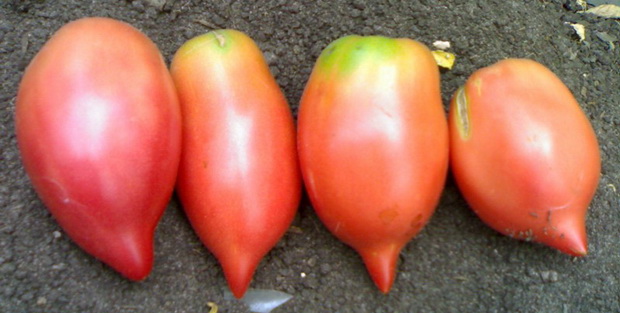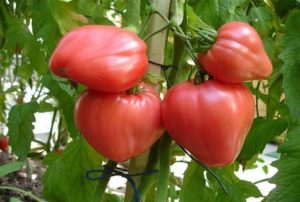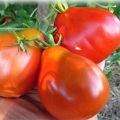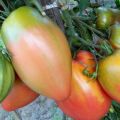Characteristics and description of the Tomato variety Vovyi Ears, its yield
Cow's Ears Tomatoes belong to salad varieties. This variety has advantages and disadvantages. It is worth considering that almost all indicators - growth, formation of a bush, duration of fruit ripening - are inferior to their taste. However, it is precisely because of the excellent taste that the popularity of the Volovye ear tomato for growing in summer cottages does not fade away. By the way, this variety is very similar in taste to the Bovine Lob.
Characteristics and features
Characteristics and description of the tomato variety Ox ears claim that its first fruits ripen at the end of the summer season. Tomatoes are distinguished by a long growth period: about 110-115 days pass from the emergence of seedlings to the ripening of fruits. That is why some summer residents consider the cultivation of ox ears is not relevant. This is due to the fact that by the end of summer, almost everyone had already harvested early tomatoes and made preparations for the winter on their basis.
Despite the late ripening of tomatoes, any summer resident who at least once tastes the taste of these tomatoes will give preference to growing this particular salad variety.
This choice is due not only to excellent taste, but also to the following advantages:
- the fruit is of medium density, its pulp is distinguished by a delicate structure;
- fruits are cylindrical in shape, with a flat surface, solid red saturated color;
- the gamut of tomatoes is maximally revealed in absolutely all regions, since the content of organic acids and sugars is balanced in their pulp;
- the plant is determinant, its height can reach 60-80 centimeters;
- rich yield of the variety - on average, 6.3 kilos of tomatoes can be obtained from 1 square meter;
- the average weight of 1 fruit is 100 grams.
Many summer residents complement the description of tomatoes with some disadvantages:
- in the middle of the fetus there is a light vein, which is very noticeable when cut;
- the seed chambers are only partially filled, which creates a feeling of emptiness;
- lack of supports for branches can lead to their damage, loss of some part of the crop.
Experienced gardeners say that by ensuring proper planting and caring for the plant, disadvantages are minimized.
Growing
This variety should be grown in seedlings. Preparing seedlings is required according to the following instructions:

- The seeds are treated with a solution of potassium permanganate, then thoroughly washed, dried, soaked for 12 hours in any growth stimulator.
- At this time, the ground is being prepared. Suitable soil can be obtained by mixing garden soil with peat or humus. To make the soil more nutritious, you can add a small amount of wood ash to it.
- The seeds are sown in shallow holes, covered with soil, and moistened.
In order for the first shoots to appear on the soil surface faster, it is necessary to ensure optimal temperature indicators of the environment.
The plant is actively developing at temperatures above 25 degrees. After shoots appear on the surface of the earth, the temperature should be reduced, and the containers should be placed in a lighted place.
Seedlings should be dived only after several full-fledged leaves appear above the soil surface. The plant should be fed with a complex fertilizer. It is necessary to transplant in the second half of May, when at least 1 flower brush and 6 leaves are formed at the plant.
Care
Bovine ears need the following care:
- The first days after planting the plant in open ground, it must be covered with a film.
- Form 1 or 2 stems should be with the removal of stepsons above 3 brushes.
- A support structure must be built to support tall plants.
- During the planting season, the plant should be fed three times with complex fertilizer.

One of the advantages of the Ox Ears tomato is that the tomato is resistant to pathogens. However, gardeners still recommend preventive treatment of plantings. Such a measure will help to completely eliminate the risk of damage to the bush by late blight, root, gray and apical rot.
With proper care, the cow's ear bears large, juicy fruits that will decorate any table and an excellent ingredient for preparing not only salads, but also drinks and sauces.








